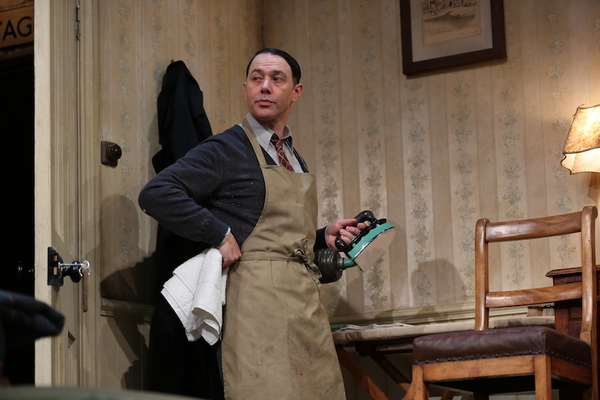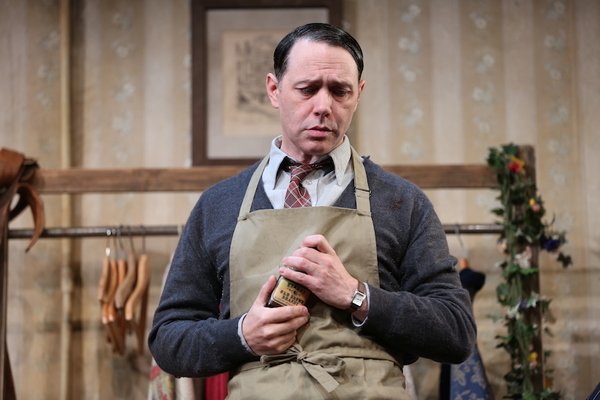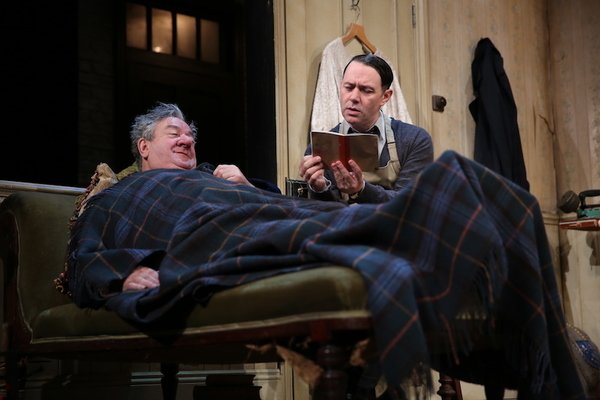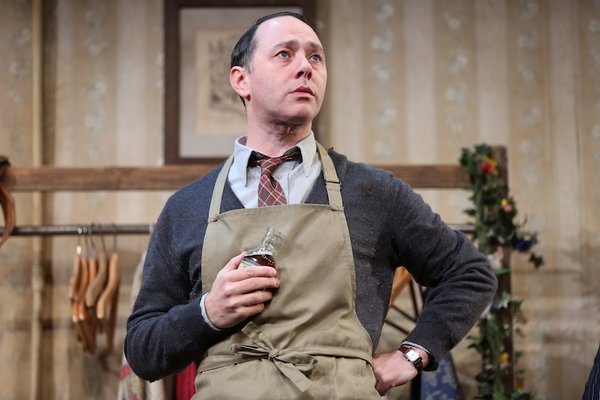“I just like things to be lovely. No pain, that’s my motto” [Norman, ‘The Dresser’, Act I]
“We all have our little sorrows, ducky, you’re not the only one. The littler you are, the larger the sorrow. You think you loved him? What about me? [Norman, ‘The Dresser’, Act II]
At its very best, live theatre is a unique artistic experience, both for the actor on stage and the audience in the auditorium.
For the actor, theatre acting not only involves the necessities of concentration and discipline, but also offers a freedom to explore and develop the role, bound only by the strictures within the character. It provides an evolving creative space to make nuanced choices in tone, shading and emphasis as well as the chance to introduce bits of business which give further intimation of a character’s inherent condition.
Detailed study of the text, fertile creative rehearsal and especially the rigours of eight performances a week enable the actor to delve deeper between and behind the lines of the original play’s text to articulate what is left unsaid, whilst honouring the truth and essence of the part.
The craft of stage acting is about developing a greater understanding of a character – their desires, dilemmas and desperation, what motivates and drives them – with the actor forging new layers of emotion latent in the play and within the role. This is by dint of the journey of discovery and growth that an actor goes through when they spend time, physically and emotionally, with a character during a play’s run.
It is the close relationship an actor has with a part he is playing for a marked length of time that is at the heart of the theatre experience for the audience as well. The distillation of choices – the ability to alter and play with variations in detail, resonance and emotional expression – which is exclusively available to the stage actor, is the creative distinctiveness that is particular to the theatre. Moments captured on stage are delicately different and subtly change at each performance, thereby making every performance a unique event for audiences too.
Ronald Harwood’s 1980 play about a tyrannical actor manager and his dresser offers an abundance of riches for the two actors playing the central characters. Brilliantly written, there is a profusion of multifaceted attributes and an almost epic scale of dimensions to Sir, the actor manager and Norman, the dresser. The play’s thematic explorations of loneliness, isolation, failure and the different ways people react against, fight doggedly, settle for or succumb to the accumulated disappointments in life, is given pathos and believability through the layered depths of the two main characters.

At its essence, ‘The Dresser’ is a deeply moving and humane play and in Sean Foley’s superlative production the key parts of Sir and Norman are played by Ken Stott and Reece Shearsmith. Stott is an acting titan with a distinguished career of deservedly high reputation and critical acclaim for a wide range of roles. He has an exalted status and pre-eminent theatrical charisma, making him utterly perfect for the part, even before his first entrance as Sir.
Matching him is Reece Shearsmith, a consummate, supremely talented actor, who has always been adept at portraying the duality in a character and has a keen eye for accruing detail into a role. Allied to this are his unsurpassed comic skills, with a near genius ability to find humour in and mine laughs from almost any line or situation. He also has an extraordinary capacity for reaching the inner truthfulness in a role, bringing a depth of emotional intensity, as if he is living and experiencing a character’s feelings for real. It goes beyond empathy to total commitment to the part he’s playing.
It is this acting prowess that enables Shearsmith to become the perfect personification of Norman, from the first utterance of his opening line to the last turn of his head and final stare into the abyss at the end, as he stands alone and completely crushed in Sir’s dressing room. He totally inhabits and makes the part completely his own. It is as defining a performance of the role as the original Norman – Tom Courtenay’s – was.
Norman’s multi-layered complexity is a manifestation of his troubled past, the present sustenance, dilemmas and issues he carries with him in his current position of dresser and relationship with Sir and his future fears: That what he currently clings to will soon end due to the vicissitudes of the actor manager’s age and health.
This totality of a life is brilliantly denoted with an impeccable actor’s skill by Reece Shearsmith. He anchors Norman’s multifarious elements (his fastidiousness, discretion, waspishness and campness, the role of confidant and carer) and his manifesting emotions (bitterness, resentment, anger and despair) in the finely detailed, choreographed physicality of his performance, with beautifully precise gestures, posture and changing countenance. Each fleeting facial expression gives something away and the “soulful eyes” of Norman are reflected in the twin pools of sadness that Shearsmith summons from his own eyes. Then there is the tone, weight and accentuation given to particular words and phrases and the timing and beats the actor gives to certain lines. All are intrinsic to the meticulous work involved in constructing his version of Norman.
The distinct choices made in Reece Shearsmith’s nuanced acting align faithfully to the dresser’s character – expertly mining what is implicitly imparted within the play’s text – to reveal the interior life (his past, present and anxious future) coalescing within Norman. The array of subtleties, which are so skillfully deployed, work at drawing the audience in, encouraging them to look with greater intensity at what is being depicted on stage. The more intently one sees and observes Norman, the better understood he is – what his past was, his current motivations and the extent of his vulnerabilities. The dresser is the elemental and tragic figure of this production rather than Sir, due to the immense sympathy Shearsmith arouses in the part. It is the transformative power of acting at its very best.

One side of Norman’s life alluded to in the play is his past, which he refers to elliptically, carefully disengaging from the difficulties and troubles he has experienced (intimations around fragility, depression, a breakdown and a spell in Colwyn Bay are referred to as having happened to an illusory friend) by invoking his “I had a friend” stories diffusely.
There are many traits to this man and one elicited from the dualism in Shearsmith’s performance is Norman’s need to conceal, to be in control, closed-in, guarded. This can be seen in the physical detail of his slicked down short hair, in the bib apron that sheaths him, in the fastidious way he mans his domain and serves his master and in those glimpsed moments in the dressing room and as he stands in the wings silently watching Sir on stage, where Norman seems to shut down, momentarily lost in his own thoughts. These carefully delineated components in Shearsmith’s portrayal produce a feeling of a life having always been lived on the periphery and in the shadows. Norman’s homosexuality is lightly signalled but there are enough derogatory remarks by other characters (“nancy-boys”, “buggers”, “pansy fraternity”) to know this was a time when gay men lived under perpetual threat and fear of discovery, where being discreet and hidden was a way to survive.
Norman’s past makes reference to his attempts at an acting career (he has an aptitude for learning lines, recalling large swathes of dialogue and reminding Sir of opening lines) That he was attracted to a profession which is all about performance and pretence is telling. That it represented something important and fulfilled a need in him is illuminated in a beautifully played moment by Shearsmith, when Norman acts out a scene from ‘Outward Bound’ with animated joy.
Shearsmith’s creative decision to foreground Norman’s campness in his portrayal – through gesture, a fluidity in his body language and an exaggerated tone to his voice – reinforces the idea that performance is a form of protection for Norman. Camp is heightened behaviour, in which ostentatiousness and artifice are used to form an impression of command and being in control. There is a dynamism and energy associated with camp which Norman uses to bolster his position and own sense of usefulness and importance. Amplified energetic endeavours – he keeps himself busy and immersed in activity – are a distraction from his fraying inner doubts and done to try and convince himself that he is indispensable to Sir. There is such energy and drive to Reece Shearsmith’s performance in Act I – the liveliness and forced cheerfulness (“It’s a disease…hopefulness” as Madge terms it) he gives Norman is discernible and striking. You really get a sense of the desperation behind it and the feeling that the dresser is not only trying to rescue Sir but also save himself.

When Ronald Harwood wrote ‘The Dresser’ the era of the actor manager touring theatre companies – Sir and Norman’s world – was already part of a bygone age, a distant memory. The play makes clear that the realm of the actor manager was a hierarchical and unyielding one, built on rank and status, with the entire company subsumed beneath the power and capriciousness of Sir.
Although the altruistic noble cause of bringing culture to the provinces was its idealised, messianic public service creed, as ‘The Dresser’ relates, its domain was as much to serve the egotism and ambition of the actor manager. The weekly rotating of Shakespeare plays was the means by which the actor manager could achieve a legendary acting reputation, building up a set of definitive Shakespearean performances. The play cites how the eluded prize of a knighthood and the favoured echelon of actors rankles Sir, in a profession infected with jealousy, insecurity and competitiveness.
Single-minded focus, self-absorption, selfishness and obsession drive Sir. There is no room for considering the feelings of others. For Norman, who derives his fragile sense of self-worth and life’s purpose from being Sir’s dutiful dresser, the thin veil of illusion that Sir holds him in the kind of regard which he aches for (and the out of reach hope for a little approbation and attention) is rapidly descending by the time the audience first meets him, in a perturbed mood in Sir’s dressing room. It is why, when the audience sees the pair alone together, as Norman rouses, placates and prepares Sir – with an almost missionary zeal – to give his 227th performances as King Lear, the dresser is also seeking solace from a neatly tucked away bottle of alcohol.

Although it is set in a theatrical world that has passed, ‘The Dresser’ also feels remarkably prescient in its depiction of the titular character in the grip of a destructive co-dependency. When Harwood wrote the play, the term was not yet in the arena of public discourse or widely recognised beyond a circle of experts, but Norman has the full spectrum of co-dependency symptoms: Seeing oneself as indispensable to the care receiver; a tendency to become hurt when their efforts aren’t recognised; an exaggerated sense of responsibility; an extreme need for approval and recognition; a fear of being abandoned; chronic anger and feelings of inadequacy. These elements resonate powerfully as the dresser increasingly falls apart during the second act.
Over the course of the play Sir censures Norman harshly several times, reminding him of his lowly status, that theirs is a master-servant relationship based on the dresser’s servitude. When Sir fails to praise or even thank him backstage during the interval breaks between his performance of King Lear, when the dresser is desperately seeking it the most, the audience watches as Shearsmith (as Norman) almost visibly crumbles, his face registering desolation.
The climax of the play unleashes a deluge of emotion from Norman. It is what the relationship between Sir and his dresser has been leading up to. Shearsmith’s performance scales new heights of artistic brilliance as the crushed dresser’s fragile facade shatters and a torrent of feelings – anger, pain, bitterness, outrage, regret, distress – come pouring out. There is such a truthful, natural force to the way he expresses Norman’s damaged, broken sense of self that it is truly devastating to watch. One is hushed, mesmerised and completely transfixed – it feels like a cry from the heart that speaks to anyone who has given everything to someone and had nothing back in return. The intensity of emotional commitment from Shearsmith is so grounded in honesty, sincerity and pure truthfulness that there’s not a trace of actorly artifice on show. It is as if he is experiencing Norman’s pain for real as he faces the traumatic realisation that he has given sixteen years of his life and is now alone and left with nothing. So forceful is that final, emotionally gut-wrenching scene in the dressing room that it becomes Norman’s storm – to match and equal the one in King Lear – such is the outpouring of rage, emotional potency and heartbreaking poignancy in Shearsmith’s acting. The first time I saw him perform this scene it left me feeling overwhelmed and completely stunned. It was simply an extraordinary moment in the theatre for me, witnessing an actor give of himself to that extent.

The difference between a consummate performance and one that touches greatness is in the journey of discovery an actor goes through when playing a role. Greatness is reached when an actor is able to reveal the totality of a character through the depth of emotion reached and by the varieties of nuance and array of subtleties deployed to explore the part. Above all – when the role is one in an already established and well-known play – it is when the actor brings something new and different to the portrayal, creating a revelatory and deeper understanding of a character than has gone before.
Reece Shearsmith’s Norman is one of the great stage performances of recent times, in a production of ‘The Dresser’ that is exemplary in every way and as close to perfection as it is possible to get. His commitment to the role and transformative skill to inhabit and completely live the part on stage will stay with me for as long as I live.

Cast
Reece Shearsmith……Norman
Ken Stott……Sir
Harriet Thorpe……Her Ladyship
Selina Cadell……Madge
Simon Rouse……Geoffrey Thornton
Adam Jackson-Smith……Oxenby
Phoebe Sparrow……Irene
Creatives
Playwright……Ronald Harwood
Director……Sean Foley
Producers……Mark Goucher/Mark Rubinstein Ltd/Jonathan Church Productions
Set Designer……Michael Taylor
Stage Manager……Sid Higgins
Production
Richmond Theatre, Brighton Theatre Royal, Everyman Theatre, Cheltenham (12th September-1st October 2016)
Duke of York’s Theatre (5th October 2016-14th January 2017)
Chichester Festival Theatre (25th January-4th February 2017)

Again, beautifully written detailed analysis. Wish I could’ve seen this play! Next time we will go together 🙂 xxxx
LikeLike